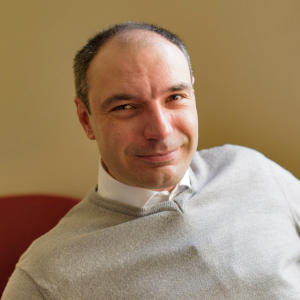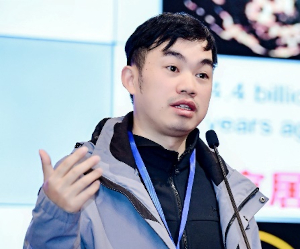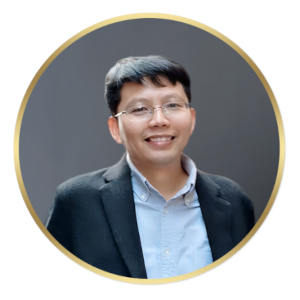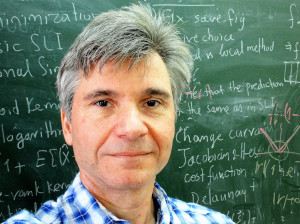Keynote speakers and IAMG Awardees
Keynote Speakers
- Dr. Alik Ismail-Zadeh, Karlsruhe Institute of Technology
- Anna Nguno, Deputy Director at the Geological Survey of Namibia
IAMG Awardees
- Prof. Dario Grana, University of Wyoming - Felix Chayes Prize 2025
- Prof. Guoxiong Chen, China University of Geosciences (Wuhan) - Andrei Borisovich Vistelius Research Award 2025
- Dr. Anirudh Prabhu, Carnegie Institution for Science - Andrei Borisovich Vistelius Research Award 2025
- Prof. Renguang Zuo, China University of Geosciences (Wuhan) - Distinguished Lecturer 2026
- Prof. Dionysios Christopoulos, Technical University of Crete - Georges Matheron Lecturer 2024
Keynote Speakers↑
Alik Ismail-Zadeh↑
 Alik Ismail-Zadeh is Research Professor at the Karlsruhe Institute of Technology, Karlsruhe, Germany. He is a mathematical geoscientist known for his contribution to computational geodynamics and natural hazard studies and pioneering work on data assimilation in geodynamics. His research covers several topics in geosciences and applied mathematics: mantle/lithosphere dynamics, seismology, volcanology, sedimentary basins, tectonophysics, geohazards, risk analysis as well as gravitational and thermal instabilities, inverse problems, and numerical techniques. His research methods include multi- and interdisciplinary synthesis, theoretical analysis, and numerical experiments. He is a principal author and co-author of over 150 peer-reviewed papers and several books.
Alik Ismail-Zadeh is Research Professor at the Karlsruhe Institute of Technology, Karlsruhe, Germany. He is a mathematical geoscientist known for his contribution to computational geodynamics and natural hazard studies and pioneering work on data assimilation in geodynamics. His research covers several topics in geosciences and applied mathematics: mantle/lithosphere dynamics, seismology, volcanology, sedimentary basins, tectonophysics, geohazards, risk analysis as well as gravitational and thermal instabilities, inverse problems, and numerical techniques. His research methods include multi- and interdisciplinary synthesis, theoretical analysis, and numerical experiments. He is a principal author and co-author of over 150 peer-reviewed papers and several books.
Alik Ismail-Zadeh has been Secretary General of the International Union of Geodesy and Geophysics (IUGG, 2007-2019) and inaugural Secretary General of the International Science Council (ISC, 2018-2021), which represents science as a global voice at the United Nations (UN). Currently, he is Chair of the IUGG Commission on Mathematical Geophysics and Chair of the ISC-UNDRR Scientific Committee of the Integrated Research on Disaster Risk. Alik Ismail-Zadeh is a Member of Academia Europaea, Fellow of the American Geophysical Union, of the International Union of Geodesy and Geophysics, of the International Science Council, and Honorary Fellow of the Royal Astronomical Society. He honored by several prestigious professional awards and medals.
Talk title: Data-Driven Computational Modelling in Geodynamics
Deep geodynamic processes and their surface manifestations, such as seismicity or volcanism, are of great scientific interest and of societal relevance. With great advances in understanding the geodynamic processes based on geological analysis, geophysical and geodetic monitoring, observations and data analysis as well as with novel mathematical methods and technological progress in computer simulations, data-driven computational models in geodynamics become feasible and important in recovering the past, analysing the present, and forecasting the future. If traditional geodynamic models are related to analyses of basic dynamical processes in and on the Earth without a direct linkage to observations, data-driven models try to assimilate Earth observations and relevant data models via physics-based numerical models to determine either optimal characteristics of the models or initial/boundary conditions. Data assimilation techniques, e.g., adjoint or quasi-reversibility, employed for analysis of geodynamic processes as well as AI methods used in computer vision, e.g., for identification of parameters of physics-based models based on geomorphological shapes, permit for utilising huge observations via models. During the talk I shall present case studies related to mantle-lithosphere dynamics, earthquake occurrence, and lava dynamics. These case studies enhance our knowledge on the dynamics of the planet as well as contributes to the solutions of societal challenges related to georesources and geohazards.
Anna Nguno↑
 Anna Nguno is a seasoned geologist with over 25 years’ experience in public service. She currently serves as a Deputy Director at the Geological Survey of Namibia (GSN) under the Ministry of Industries, Mines and Energy (MIME). Holding an MSc in Geology and Mineralogy from the University of Helsinki, Finland, she has extensive expertise in spearheading geological mapping projects. Additionally, she played a key role in developing Namibia’s geoscience data infrastructure and fostering collaborations with local and international research institutions.
Anna Nguno is a seasoned geologist with over 25 years’ experience in public service. She currently serves as a Deputy Director at the Geological Survey of Namibia (GSN) under the Ministry of Industries, Mines and Energy (MIME). Holding an MSc in Geology and Mineralogy from the University of Helsinki, Finland, she has extensive expertise in spearheading geological mapping projects. Additionally, she played a key role in developing Namibia’s geoscience data infrastructure and fostering collaborations with local and international research institutions.
She holds leadership positions in several professional organizations, including Vice-President for Southern Africa at the Geological Society of Africa, President of the Geoscience Council of Namibia, Vice-President (Sub-commission for Africa Maps, Commission for the Geological Map of the World (CGMW), Committee Member and a member of multiple international technical working groups (i.e., AU- African Mineral and Energy Resources Classification and Management System (AMREC)- and Pan African Resource Reporting Code (PARC), Member of the IUGS Nominating Committee for the term 2020-2024.
Her contributions extend to global geoscience policy development, continental resource classification frameworks, and promoting national geoscience awareness in schools and the public at large. She recently chaired the LOC of the 29th Colloquium of African Geology (2023) and Co-chaired the Society of Economic Geologists (SEG2024) conference in Windhoek, Namibia.
Talk title: Unlocking Geological Resource Potential and Fostering Institutional Development through Cross-Border Collaboration: A lesson from Southern Namibia
Quality of geological mapping in Namibia various considerably; among the parts of the country only mapped at regional scales (1:100 000 to 1:250 000) was the Karas Region, situated along the border with South Africa. Moreover, existing maps were more than 40 years ago and due for revision employing modern research and mapping techniques, and scientific insights. Between 2013 and 2022, the “Southern Namibia Mapping Programme” (SNMP) was carried out by a joint team of mapping geologists from the Geological Survey of Namibia (GSN) and the Council for Geoscience (South Africa), supported by both Namibian and South African university students and academics.
The aim of SNMP was to produce more detailed, updated 1:50 000 scale geological maps of the area north of the Orange River to align with the geology already mapped to the south, in South Africa. These maps will contribute significantly to the economic development of the region, as well as to the long-term national geoscience objective of acquiring 1:50k geological map coverage for the entire country. Furthermore, the programme aimed to build mapping and research capacity at GSN.
To achieve this object, SNMP integrated field mapping, remote sensing, geochemical and geochronological analysis. Over the ten-year period, ninety-five 1:50 000 and four 1:250 000 scale geological maps (covering some 55 000 km2) of this geologically complex and highly prospective area in southern Namibia were completed. In addition, collaboration between governmental, parastatal and academic institutions from Namibia, South Africa and Canada resulted in 18 peer-reviewed publications in international journals, 34 conference abstracts, and 20 post-graduate research projects and degrees.
The successful conclusion of SNMP shows that major mapping programmes provide a platform for government and research institutions to collaborate on common objectives, share data and exchange expertise, with enhanced capacity and know-how not the least of their many benefits.
IAMG Awardees↑
Dario Grana - Felix Chayes Prize 2025↑
 Dario Grana is a professor in the Department of Geology and Geophysics at the University of Wyoming, where he holds the Wyoming Excellence Chair and the Nielson Faculty Fellowship. He also serves as the director of the Bayesian Learning Consortium in the School of Energy Resources. He earned an MS in Mathematics from the University of Pavia (Italy) in 2005 and a Ph.D. in Geophysics from Stanford University in 2013, before joining the University of Wyoming that same year. He is the author of Seismic Reflections of Rock Properties (2014) and Seismic Reservoir Modeling (2021) and has published over 100 papers in peer-reviewed journals. His contributions to geophysics have been recognized with several prestigious awards, including the 2015 Mathematical Geosciences Best Paper Award, the 2016 SEG Karcher Award, the 2017 EAGE Van Weelden Award, and the 2022 SEG Outstanding Educator Award. His research focuses on petrophysics, rock physics, geostatistics, data assimilation, and inverse problems for subsurface modeling.
Dario Grana is a professor in the Department of Geology and Geophysics at the University of Wyoming, where he holds the Wyoming Excellence Chair and the Nielson Faculty Fellowship. He also serves as the director of the Bayesian Learning Consortium in the School of Energy Resources. He earned an MS in Mathematics from the University of Pavia (Italy) in 2005 and a Ph.D. in Geophysics from Stanford University in 2013, before joining the University of Wyoming that same year. He is the author of Seismic Reflections of Rock Properties (2014) and Seismic Reservoir Modeling (2021) and has published over 100 papers in peer-reviewed journals. His contributions to geophysics have been recognized with several prestigious awards, including the 2015 Mathematical Geosciences Best Paper Award, the 2016 SEG Karcher Award, the 2017 EAGE Van Weelden Award, and the 2022 SEG Outstanding Educator Award. His research focuses on petrophysics, rock physics, geostatistics, data assimilation, and inverse problems for subsurface modeling.
Talk title: Revealing Subsurface Petrophysical Properties Through Bayesian Learning
Estimating rock and fluid properties is essential for understanding subsurface processes that control fluid flow in applications ranging from hydrocarbon exploration and CO₂ sequestration to near-surface groundwater studies. This research focuses on Bayesian inverse methods for the prediction of petrophysical properties, such as porosity, permeability, mineral composition, elastic stiffness, and fluid content, from geophysical measurements, including seismic and electromagnetic data. These approaches address nonlinear and non-Gaussian models, leading to a more accurate representation of the complex relationships between geophysical observations and petrophysical properties, as well as their multimodal distributions. By combining rock physics modeling, inverse theory, and geostatistics, these methods provide full posterior distributions of predicted properties, allowing for rigorous uncertainty quantification. Their effectiveness is demonstrated across multiple geological settings and data types, showing an improved predictive capability where direct observations are sparse. Furthermore, the integration of the probabilistic framework with deep learning opens new directions for robust subsurface characterization in both energy and environmental contexts.
Guoxiong Chen - Andrei Borisovich Vistelius Research Award 2025↑
 Guoxiong Chen is a professor at the China University of Geosciences (Wuhan) and Deputy Director of the State Key Laboratory of Geological Processes and Mineral Resources. He serves as Associate Editor for both Mathematical Geosciences and Ore Geology Reviews, while holding positions as subgroup leader of the IUGS International Lithological Program (LIP) and co-leader of the Mathematical Geology Working Group in the IUGS Deep-Time Digital Earth (DDE) Big Science Program. Dr. Chen maintains broad research interests across geoscience disciplines, with particular emphasis on employing mathematical modeling and innovative methodologies to investigate fundamental questions regarding the evolution of habitable Earth and resolve technical challenges in mineral exploration. As an early-career scientist, he has authored over 30 SCI-indexed publications in leading journals including Nature Communications, Science Advances, Geology, and Earth and Planetary Science Letters, as well as specialized IAMG journals.
Guoxiong Chen is a professor at the China University of Geosciences (Wuhan) and Deputy Director of the State Key Laboratory of Geological Processes and Mineral Resources. He serves as Associate Editor for both Mathematical Geosciences and Ore Geology Reviews, while holding positions as subgroup leader of the IUGS International Lithological Program (LIP) and co-leader of the Mathematical Geology Working Group in the IUGS Deep-Time Digital Earth (DDE) Big Science Program. Dr. Chen maintains broad research interests across geoscience disciplines, with particular emphasis on employing mathematical modeling and innovative methodologies to investigate fundamental questions regarding the evolution of habitable Earth and resolve technical challenges in mineral exploration. As an early-career scientist, he has authored over 30 SCI-indexed publications in leading journals including Nature Communications, Science Advances, Geology, and Earth and Planetary Science Letters, as well as specialized IAMG journals.
Talk title: Data-driven traveling in deep time: a unique way of mathematical geologists for exploring the operation of early Earth.
Anirudh Prabhu - Andrei Borisovich Vistelius Research Award 2025↑
 Anirudh Prabhu is a Research Scientist & Principal Investigator at the Earth and Planets Laboratory in the Carnegie Institution for Science. A data & information scientist by training Prabhu's research focuses on advancing data science by developing and applying analytics, and machine learning techniques, thus answering the biggest questions in science including but not limited to
Anirudh Prabhu is a Research Scientist & Principal Investigator at the Earth and Planets Laboratory in the Carnegie Institution for Science. A data & information scientist by training Prabhu's research focuses on advancing data science by developing and applying analytics, and machine learning techniques, thus answering the biggest questions in science including but not limited to
- understanding the evolution of Earth's geosphere and biosphere,
- identifying and characterizing planetary kinds,
- biosignature detection, and
- understanding the role of information in complex evolving systems. Prabhu's current research applications include the fields of Mineralogy, Astrobiology, Paleobiology, Crystallography, and Planetary Science.
Talk title: Learning from Data, Learning from Planets: AI methods for Earth and Space Exploration
Renguang Zuo - Distinguished Lecturer 2026↑
 Professor Renguang Zuo received his B.S. and Ph.D. degrees from the China University of Geosciences (CUG), Wuhan, China, in 2004 and 2009, respectively. He is currently a full professor at the State Key Laboratory of Geological Processes and Mineral Resources, CUG.
His research focuses on big data analytics and machine learning-based mineral prospectivity mapping and geochemical anomalies identification. Dr. Zuo has published over 160 peer-reviewed journal papers, 6 books, and book chapters. He has served as the Gust Editor for 8 special issues in international high-quality journals. His publications have amassed over 9,000 citations (Google scholar) across a range of esteemed international journals. In 2023, Dr. Zuo was awarded the Gold Medal, which is the highest award by the Association of Applied Geochemists (AAG). Meanwhile, Dr. Zuo was selected as the IAMG Distinguished Lecturer 2026. In addition, he was the inaugural recipient of the Kharaka Award by the International Association for GeoChemistry in 2015.
Professor Renguang Zuo received his B.S. and Ph.D. degrees from the China University of Geosciences (CUG), Wuhan, China, in 2004 and 2009, respectively. He is currently a full professor at the State Key Laboratory of Geological Processes and Mineral Resources, CUG.
His research focuses on big data analytics and machine learning-based mineral prospectivity mapping and geochemical anomalies identification. Dr. Zuo has published over 160 peer-reviewed journal papers, 6 books, and book chapters. He has served as the Gust Editor for 8 special issues in international high-quality journals. His publications have amassed over 9,000 citations (Google scholar) across a range of esteemed international journals. In 2023, Dr. Zuo was awarded the Gold Medal, which is the highest award by the Association of Applied Geochemists (AAG). Meanwhile, Dr. Zuo was selected as the IAMG Distinguished Lecturer 2026. In addition, he was the inaugural recipient of the Kharaka Award by the International Association for GeoChemistry in 2015.
Dr. Zuo is the Vice President of AAG (2025-2026), and was a council of IAMG (2020-2024). He has received fellowships from AAG, Society of Economic Geologists, and Geological Society of London. He has been heavily involved in the editorial boards of many SCI-indexed journals, including Journal of Geochemical Exploration, Geochemistry: Exploration, Environment, Analysis, Computers & Geosciences, Natural Resources Research, Ore Geology Reviews, and Journal of Earth Science.
Talk title: Data-knowledge dual-driven mineral prospectivity mapping
Dionysios Christopoulos - Georges Matheron Lecturer 2024↑
 Dionissios T. Hristopulos is a Professor in the School of Electrical and Computer Engineering at the Technical University of Crete and the director of the Master's program in Machine Learning and Data Science. He holds a Diploma in Electrical Engineering (National Technical University of Athens) and a PhD in Physics (Princeton University). He has held appointments in the Department of Environmental Sciences and Engineering (University of North Carolina at Chapel Hill, USA) and the Pulp and Paper Research Institute of Canada. In 2002, he returned to Greece in the Department of Mineral Resources Engineering at the Technical University of Crete, where he stayed until 2020 before moving to his current position. In 2003, he shared with Tetsu Uesaka the Johannes A. Van den Akker International Prize for Advances in Paper Physics. Dionissios serves on the editorial boards of Computers & Geosciences, Spatial Statistics, and Stochastic Environmental Research and Risk Assessment. He has co-authored more than 100 peer-reviewed publications and is the author of Random Fields for Spatial Data Modeling: A Primer for Scientists and Engineers (Springer, 2020). His research interests include new methodologies in spatiotemporal statistics, statistical physics, machine learning, and their applications.
Dionissios T. Hristopulos is a Professor in the School of Electrical and Computer Engineering at the Technical University of Crete and the director of the Master's program in Machine Learning and Data Science. He holds a Diploma in Electrical Engineering (National Technical University of Athens) and a PhD in Physics (Princeton University). He has held appointments in the Department of Environmental Sciences and Engineering (University of North Carolina at Chapel Hill, USA) and the Pulp and Paper Research Institute of Canada. In 2002, he returned to Greece in the Department of Mineral Resources Engineering at the Technical University of Crete, where he stayed until 2020 before moving to his current position. In 2003, he shared with Tetsu Uesaka the Johannes A. Van den Akker International Prize for Advances in Paper Physics. Dionissios serves on the editorial boards of Computers & Geosciences, Spatial Statistics, and Stochastic Environmental Research and Risk Assessment. He has co-authored more than 100 peer-reviewed publications and is the author of Random Fields for Spatial Data Modeling: A Primer for Scientists and Engineers (Springer, 2020). His research interests include new methodologies in spatiotemporal statistics, statistical physics, machine learning, and their applications.
Talk title: From Particles to Patterns: An Odyssey from Physics to Geostatistics and Beyond
Are there useful connections between statistical physics and geostatistics? Does quantum many-body theory have similarities with random fields? Is it worth learning how to use kriging in the era of artificial intelligence (AI)? This presentation gives affirmative answers to the questions above. We will show that the geostatistical framework fits nicely inside the framework of Gaussian process regression, thus making the connection of geostatistics with the field of AI. Gaussian process regression (kriging as well) faces computational difficulties for very large datasets due to the inversion of the covariance matrix which scales cubically with data size. One solution to this problem exploits an idea from statistical field theory, namely the formulation of joint densities by means of field interactions. This change in perspective, compared to the standard, covariance-based formulation, puts the precision (inverse covariance) matrix at the forefront and avoids inversion of the covariance matrix for spatial prediction or for model likelihood estimation. The stochastic local interaction (SLI) models derived by pursuing this idea can be viewed as Markov random fields with physically inspired precision matrices, and they have significantly lower computational complexity compared to kriging. The range of the interactions in SLI models is determined by adaptively controlling the range of user-selected interaction kernels. In the continuum limit, precision matrices are replaced by precision operators. We will show that by combining a particular precision operator with yet another idea from statistical physics, namely smoothed particle hydrodynamics, we obtain the first representation of a continuum precision (inverse covariance) function. For data with non-Gaussian distribution, the idea of warped Gaussian processes (a close relative of Gaussian anamorphosis) is often useful. We will present a new, flexible nonlinear transformation for warped Gaussian processes using mathematical tools developed for generalized entropies. Finally, we will consider the Ising model, a cornerstone in statistical physics and complex systems, and how it can be used for spatial data analysis. We will conclude the presentation with some remarks on future perspectives.

